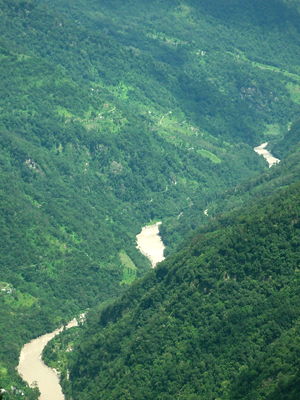Raid on Sikkim
: Insensitive Relief

by Jigme N Kazi
Sikkim need not be raped again and again to meet India's energy needs. It has paid enough to secure the country's frontiers in the eastern Himalayas. If New Delhi wants to exploit hydro potential to meet the nation's requirements, it should look somewhere else. The Sikkimese have sacrificed their freedom and sovereignty to meet India's security concerns. This truth has been kept out of the public domain by the establishment and, unfortunately, a section of the national media.
Why was the Centre so quick in announcing a Rs 1,000-crore earthquake relief package for Sikkim when the state authorities were still fumbling over the extent of damage caused by the devastating 18 September (6.8 on the Richter scale) earthquake? Did the rush to Sikkim by Central leaders after the quake reflect their concern for the welfare of the people or the companies that are in charge of hydropower projects in North Sikkim?
While the affected areas of Lachen, Lachung and Dzongu - largely inhabited by indigenous minority Bhutia-Lepcha tribals in North Sikkim - were totally ignored at the initial stage, the civil and army authorities' main focus was Chungthang, Pagong and Suffu in the region.
These were the worst affected areas as almost all those who died in the quake were workers, including officials, of the 1,200-MW Stage III Teesta Hydro Project, the biggest such in the state. This controversial programme falls under the Teesta Urja Project of the Athena Group of companies. The haste and the highly objectionable manner in which the state government, in collaboration with the Centre, brokered a deal with Teesta Urja is known to many. Despite local opposition, including the longest hunger-strike in the state, to these projects, the authorities lent a deaf ear and went ahead.
Power-brokers, who first pretended to side with the Lepcha-dominated Affected Citizens of Teesta in opposing hydro projects in Dzongu, helped negotiate a deal between anti-dam activists and the state government in 2008, leading to the protest being called off.
If one takes a careful look around, those, including the so-called anti-dam activists who benefited from this deal, now find a place in the establishment's administrative and business set-up. Nobody reports on these things for fear of incurring the wrath of the powers-that-be. However, many people are aware of the hidden agenda of these power-brokers and how they function. And, as usual, life goes on and the construction of mega hydro projects, too, continues.
The courts of law ought to take suo moto cognisance of reports that reveal the involvement of influential persons, including politicians and government officials, in mega hydro projects in Sikkim. It is alleged that Jagan Reddy, son of former Andhra Pradesh chief minister YSR Reddy who died in a chopper crash, is one of the main shareholders in the Teesta Urja Project. Who are the others? Most of the Rs 1,000-crore relief funds will surely go towards repair and construction of the road network in the state and it is expected that a large amount of this would be spent on the Toong-Pagong-Chungthang's highway in North Sikkim where power construction works are underway.
Sikkim lies in the seismic zone and experts have already given their views against mega dams in the region. What is the use of asking these experts to dish out the same thing again and again? The authorities are buying time and allegedly mollifying victims with money-power and vague assurances. They will eventually carry out their grand design to finish Sikkim. But in the process they would have achieved their hidden agenda - making a fast buck in the name of development and tapping hydro power potential.
When enough is still not enough, the only thing that will put a final end to human greed in this part of mountain country is another big shake-up that will place everyone and everything in the Teesta river for onward disposal in the Indian Ocean.
Remember this well: Mangan, headquarters of North Sikkim, was not the epicentre of the 9/18 earthquake - it was Khangchendzonga, the abode of Sikkim's guardian deities. Conscious Sikkimese who have helplessly fought vested interests in preserving Sikkim's natural and cultural heritage are convinced that their Yul-lha zhibda (country gods) have come to their rescue at the right time. Man's extremity is indeed God's opportunity. I would wish to repeat that those whom the gods wish to destroy they first make mad. Let those who fail to heed the warning go ahead in their mad rush towards self-destruction.
Jigme N Kazi is editor of the Gangtokian Sikkim Observer. He was awarded Khangchendzonga Kalam Puraskar by the Press Club of Sikkim - much too late - in 2012.
Original Text in: The Statesman, 23rd October 2011; Photo Credit: International Rivers
